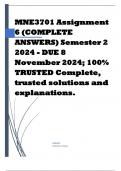MNE3701 Assignment
6 (COMPLETE
ANSWERS) Semester 2
2024 - DUE 8
November 2024; 100%
TRUSTED Complete,
trusted solutions and
explanations.
ADMIN
[COMPANY NAME]
,MNE3701 Assignment 6 (COMPLETE ANSWERS)
Semester 2 2024 - DUE 8 November 2024; 100% TRUSTED
Complete, trusted solutions and explanations.
Having acquired sufficient knowledge and skills on
entrepreneurship and small business management, you must
demonstrate practical competencies in managing small
businesses. You should also be able to identify deficiency in the
small business management practices and be able to provide
recommendations for improvement. Visit one small business in
your area with an estimated annual turnover of R2 million. Have
interview with the owner. In your interview ask him how he
manages the human resources and finances of his business. You
should also ask him to what extent he utilises technology to
support customer relationship management of his business. Use
the information that you have gathered through the interview
and answer the following questions: 1. Discuss how the owner
of the small business you have visited, manages the business’s
human resources. Do you think is there a need for improvement?
If yes, provide recommendations for improvement. (15) 2.
Discuss how the owner of the small business you have visited,
manages the business’s finances. Do you think is there a need
for improvement? If yes, provide recommendations for
improvement. (15)
To answer these questions, let’s consider a hypothetical small
business with an annual turnover of R2 million, such as a local
café in your area. After conducting an interview with the owner,
, we can analyze the human resources, finances, and technology
use in the business, identifying areas for improvement and
providing practical recommendations.
QUESTION 1: Managing Human Resources
Owner’s Approach to Managing Human Resources:
The café owner may manage their human resources informally,
as is common in small businesses. The owner likely handles
hiring, training, and scheduling personally, relying on a small
team of employees, including baristas, kitchen staff, and front-
of-house workers. Given the size of the business, the owner may
not have a dedicated HR department and may rely on direct
communication with employees for conflict resolution, task
delegation, and performance management.
• Hiring: The owner might hire staff through word-of-mouth
referrals or local job postings. There may be no formal job
descriptions or structured recruitment process.
• Training: Employees could be trained on the job, with
limited formal training sessions. Learning is likely
experiential, with newer employees learning from more
experienced ones.
• Scheduling and Payroll: The owner may use a simple
scheduling system (e.g., a spreadsheet or basic app) to
manage shifts and time-off requests. Payroll may be
calculated manually or through a basic accounting software
package.
• Employee Motivation and Retention: Motivating staff
may be informal, with occasional verbal praise and small
bonuses. The business may not offer benefits such as health





